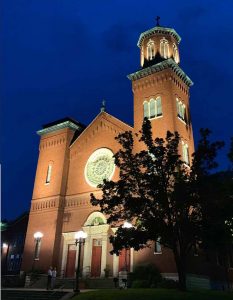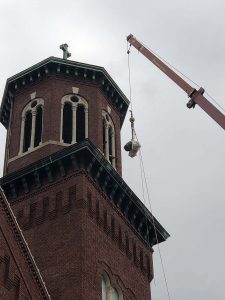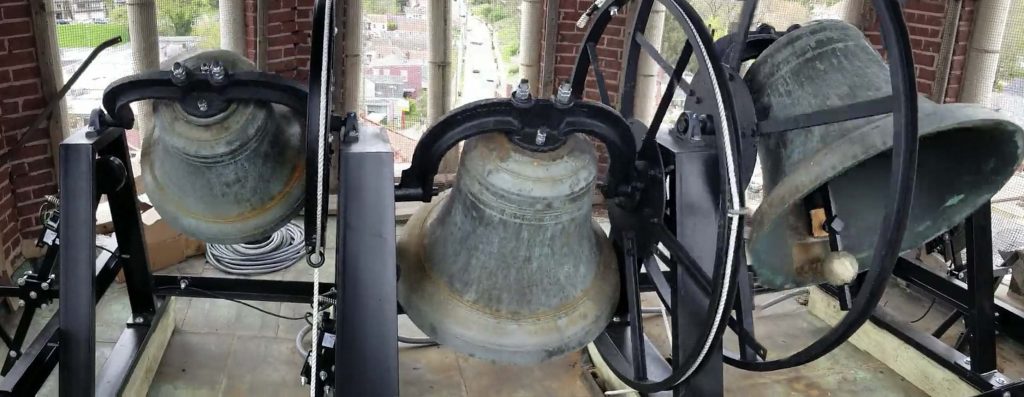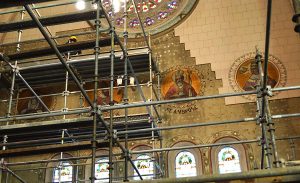By Stephen Enzweiler
Special to the NKyTribune
This is the first part of a five-part series on the 150th anniversary of St. Augustine Parish.

The illuminated façade of St. Augustine Church with the new LED lighting. Courtesy of the Capital Campaign.
This change is the result of the parish’s 2020 Capital Campaign, a $1.5 million program of needed restoration and renovation in preparation for the celebration of the parish’s 150th anniversary this year. Fundraising began in February 2018, and work on a number of projects began later that November. There have been renovations of the church building in the past, but none that had the range and scope of the Capital Campaign.
“The Capital Campaign is not trying to return the church to what it was,” explained Fr. Dan Schomaker, Pastor of St. Augustine, “but our attention is on conservation, preservation, renovation, and restoration so as to provide a place of beauty for this and future generations to worship Almighty God.”

The Verdin Bell Company of Cincinnati lifts equipment to the bell tower as work gets underway to refurbish the bell assemblies. (Courtesy of Rev. Dan Schomaker.)
The church’s once elegant oak flooring that had been covered over by carpet was found to be heaving and buckling unevenly, causing tripping hazards. The rows of pews where the faithful have sat, kneeled, and prayed are cracking, kneeler pads are ripping and the varnish has worn away. The plaster walls, covered over by acoustic tiles since 1945 are in need of cleaning, re-plastering and painting; and the historic 1927 Austin pipe organ, the voice of sacred music for many a Sunday Mass, hasn’t been heard in over three decades.
All this renovation activity of the Capital Campaign might have gone unnoticed by Peaselburg residents if it weren’t for the sudden quiet that fell over the neighborhood in January 2019. Long-time residents have heard the ringing of St. Augustine’s bells for most of their lives and regard them as old friends. The bells would have been so familiar to some that their calling would have been used to help them schedule their day—perhaps to get up in the morning, or go to work, go to school, come to Mass, eat lunch or supper, or even catch the bus.

The restored bell assembly with the bells pealing as they are rung from below with newly installed pull ropes. From left to right is the “St. Augustine” bell, the “St. Monica” bell, and the “Jesus in the Blessed Sacrament” bell, with its new copper clapper clearly visible. (Courtesy of the Verdin Bell Co.)
“Church bells announce,” says Fr. Schomaker, recalling older times when neighborhoods were drawn together by the bells, and even those without faith came to know of a place where they could go to know Jesus. “They draw the neighborhood together, Christian and non-Christian,” he says. “Bells call us to worship. They call us together in moments of joy – as in a wedding or baptism. They also toll in moments of sorrow, as when we part with those we love.”
For three months in 2019, quiet ruled over Peaselburg. Then, on the day before Easter, the sound of bells was heard again. They had been refitted with new iron yokes, trunnions, and wooden foundations; new pull ropes were installed, allowing residents to hear them pealing for the Easter Vigil as they were rung by hand.
According to tradition, each bell is named. There is the 1,000 pound, 38-inch “Jesus in the Blessed Sacrament” bell, the 550 pound, 31-inch St. Monica bell, and the 250 pound, 24-inch “St. Augustine” bell. Originally cast in 1914 at the Buckeye Bell Foundry by the E.W. Vanduzen Company of Cincinnati, the bells were first rung by hand with ropes. It was in 1937 when then-pastor Rev. Charles Woeste had the bells automated, eliminating the need for ropes. For 83 years, Woeste’s automated system called the people to worship and announced the Angelus daily at 6 a.m., noon, and 6 p.m. The recently updated automation still rings the Angelus bells as always, but it now also rings on the hour and at the half-hour.

Scaffolding rises from the floor of the church interior as workmen prepare to work on the ceiling and walls. (Photo by Stephen Enzweiler)
“The lights were added so people could see the steeple in the night,” Fr. Schomaker explains. “The importance of lighting the towers and façade is it allows the people of the neighborhood to see that God is always present in their midst, even in the darkest moments.”
The third major goal completed thus far is the installation of a state-of-the-art air climate control system for the church. This is a major improvement, especially for older and elderly parishioners who feared the interior heat index that sometimes exceeded 100 degrees, forcing many to stay home. The new VRF system is a state-of-the-art heating and air conditioning technology designed for St. Augustine by KLH Engineering of Ft. Thomas and installed by Blau Mechanical of Covington. The new technology provides both air-conditioning and heat and is designed to also safeguard the murals, statues, and musical instruments from high heat and humidity, ensuring greater longevity. On Thursday, June 6, 2019, the parishioners finally attended Holy Mass in the cool relief of a comfortable, air-conditioned church.

When workmen removed old acoustic tiles from the walls recently, they revealed stunning details from a century ago. Here, the original, ornate frames painted on the wall around portraits of Doctors of the Church are revealed, as are delicate frames painted around the rose window and stained-glass windows. (Photo by Stephen Enzweiler)
To learn more about the Capital Campaign and the restoration and renovation progress, or to make a donation, go to this website.
Stephen Enzweiler is a writer of Northern Kentucky history. He is the Cathedral Historian at St. Mary’s Cathedral Basilica of the Assumption in Covington.

One surprise beneath the acoustic tiles was the discovery of a “faux mosaic” decoration on the original plaster wall. Beneath it was a “faux wall” painted to look like stone blocks with piping and corner decorations. (Photo by Stephen Enzweiler)

One of the original murals “The Resurrection” by an unknown artist. Darkened over time, it will require a much-needed cleaning. (Photo by Stephen Enzweiler)

Detail of the restoration of the badly damaged main crucifix by Florentine-trained art conservator Veronica Lezzoni. (Courtesy of the Capital Campaign)
























